November 2019
Yuan Wang (Helena) - School of Chemistry
Yuan Wang (Helena) - School of Chemistry
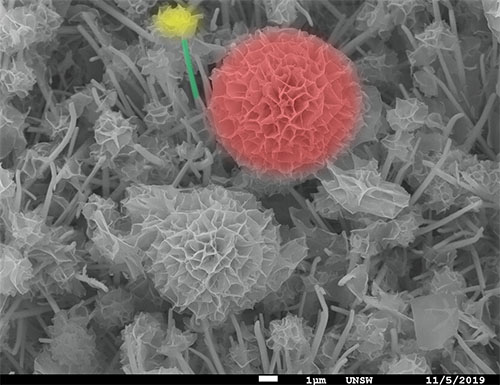
NiMoOx blossom are controllably grown on the backbone of the 3D nickel foam as effective electrocatalyst for water splitting. The stem structure connects the flower to the nickel foam, thereby increasing conductivity and electrochemical surface area.
Image by: Helena Yuan Wang-School of Chemistry
Supervisor: Professor Chuan Zhao
Microscope/Technique: SEM 450
Tao Yang - School of Chemical Engineering, Australian Centre for Nanomedicine
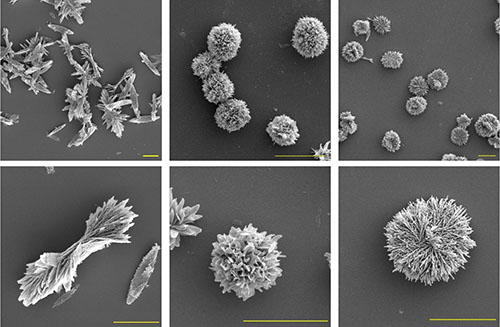
FE-SEM images illustrate zinc oxide (ZnO) particles with varied morphologies (from left to right: bowtie, flower and nest) synthesized using identical building blocks through a chemical precipitation method. Images were recorded at low (top row) and high (bottom row) resolutions. Scale bar: 5 µm.
Image by: Tao Yang
Supervisor: Dr Rona Chandrawati
Microscope/Technique: NanoSEM 230 and NanoSEM 450
Yong Zhao - School of Chemistry
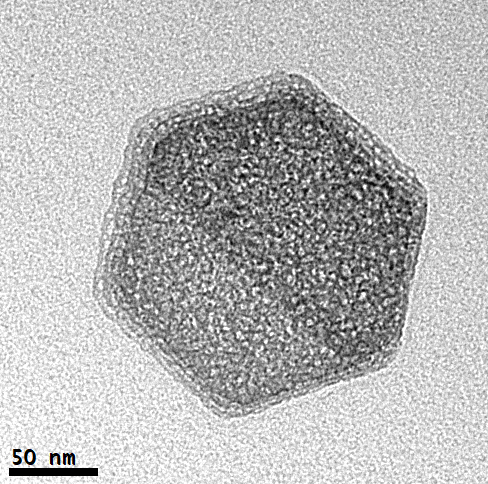
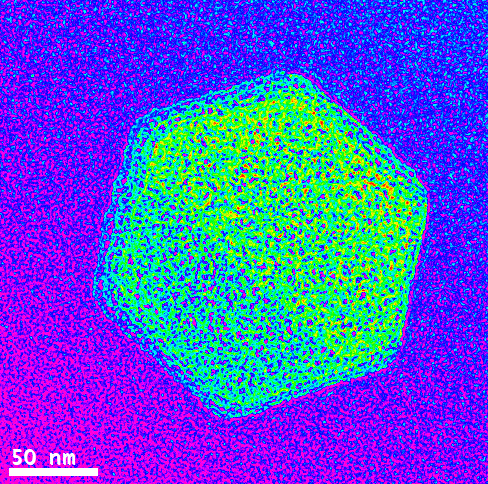
This bright field image shows a spontaneous assembly of hexagonal Pd nanosheets with {111} facet exposed on carbon film. four and a half pieces of regular Pd hexagons stacked together by a face-to-face order, which can be clearly discerned in the false-colour strengthened image. the strong electron irradiation induced the formation of nanopores on the surface of the ultrathin nanosheets.
Image by: Dr. Yong Zhao
Supervisor: Prof. Chuan Zhao
Microscope/Technique: cm200 TEM
Rokiah Alford and Jonathan Berengut, EMBL Australian Node for Single Molecule Science, School of Medical Sciences

Image by: Rokiah Alford (sample design, synthesis and preparation) & Jonathan Berengut (sample preparation and imaging)
Supervisor: Dr. Lawrence Lee
Microscope/Technique: Tecnai G2 20 TEM/ UA negative stain
Reza Shahmiri - School of Materials Science and Engineering
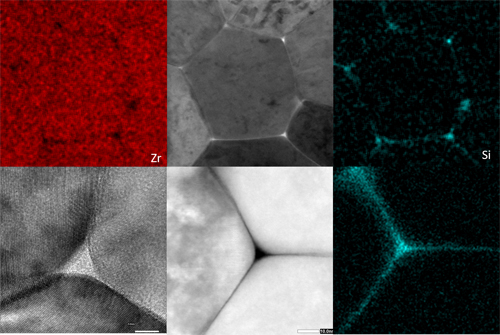
This image illustrates a grain of bio-ceramic for dental application. The powder consists of zirconia oxide doped with yttrium. Characteristics of the grain boundary are under investigation with the use of TEM/STEM.
Image by: Reza Shahmiri (with assistance of Richard Webster, Yin Yao and Qiang Zhu)
Supervisor: Dr. Owen Standard
Microscope/Technique: JEOL f200 TEM
Yuwen Xu - School of Materials Science and Engineering
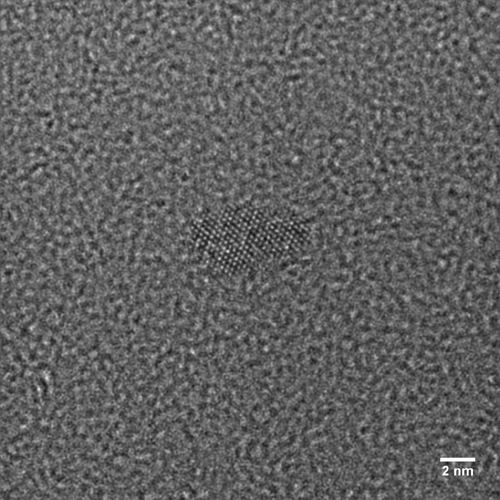
This HRTEM image shows a very tiny ceramic single crystal nuclei obtained by recrystallisation after long time aging. It exposes {111} and {100} facets and is in the two-dimensional truncated diamond shape with newly grown atomic layers near the corners.
Image by: Yuwen Xu
Supervisors: Prof. Charles C. Sorrell and Dr. Pramod Koshy
Microscope/Technique: f200 TEM
Marta Sanchez Miranda - School of Physics
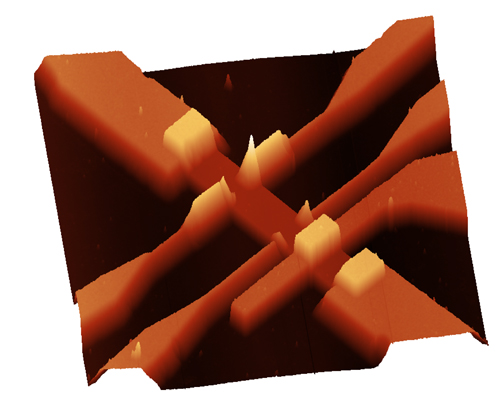
3D atomic force microscopy image: InAs nano-membrane with a set of source/drain leads, four hall contacts and an overarching top-gate, insulated by HfO2. this device allows us to gain important insights into the transport properties of these novel InAs structures grown by selective area epitaxy.
Image by: Marta Sanchez Miranda
Supervisor: Prof. Adam Micolich
Microscope/Technique: ICON AFM
Hsiang-Sheng (Johnson) Cheng - School of Chemistry
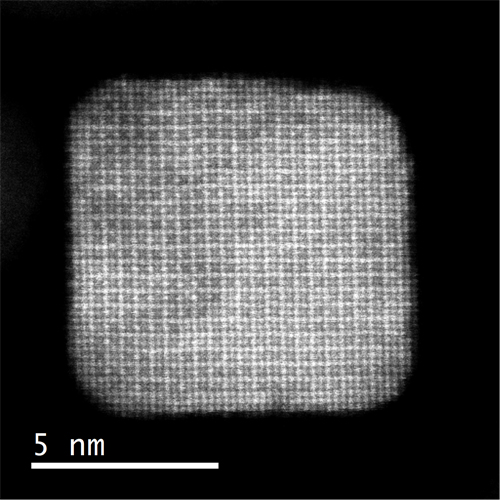
his HAADF-STEM image shows an ordered Pt3Sn@Pt core-shell in cubic shape with {100} facet exposed. The darker part shows the Sn columns while the brighter grids represent the Pt columns in a Au3Cu type ordering structure. 2-3 atomic layers of Pt shell is also observable from the Z contrast.
Image by: Hsiang-Sheng (Johnson) Chen
Supervisor: Prof. Richard Tilley
Microscope/Technique: JEOL f200 TEM
Laicong Qiao - Graduate School of Biomedical Engineering
![]()
We applied electrical technology to control the gold nanoparticle deposition on working electrode. In our experiment, the shape of gold nanoparticle could be successfully controlled (e.g. sphere, flower, dumbbell, popcorn and triangle). In addition, we could also prepare same controlled nanoparticle cluster, such as leaves, seaweed and Christmas tree cluster structures which is shown on the image. This research will provide a reliable surface roughness technology to increase sensitivity of biosensors.
Image by: Laicong Qiao
Supervisor: Dr Guozhen Liu
Microscope/Technique: NanoSEM 450
Wilson Handoko - School of Materials Science and Engineering
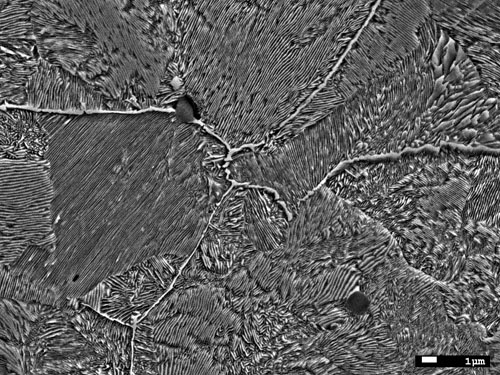
SEM micrograph of etched pearlite and micron-sized secondary phase precipitations – iron carbide (Fe3C) on the surface of high carbon steel. One inclusion was located on pearlitic phase surrounded by lamellar structures and another one was occupied along the grain boundary. This microstructure was achieved by ultra-high temperature confocal scanning laser microscope with controlled quenching rate (-60⁰C/min) on originated dual-phase (martensite and retained austensite) high carbon steel.
Image by: Wilson Handoko
Supervisors: Prof. Veena Sahajwalla and Dr Farshid Pahlevani.
Microscope/Technique: JEOL 7001f
Electron Microscope Unit:
Basement
June Griffith Building (Chemical Sciences - F10)
Kensington UNSW Sydney
NSW 2052
Tel: +61 (2) 9385 4425
Fax: +61 (2) 9385 6400
Email: EMUAdmin@unsw.edu.au

Authorised by the Executive Director of Mark Wainwright Analytical Centre, UNSW CRICOS Provider Code 00098G, ABN 57 195 873 179
Mark Wainwright Analytical Centre, UNSW, Sydney, NSW, 2052, Australia | Email: analytical@unsw.edu.au
